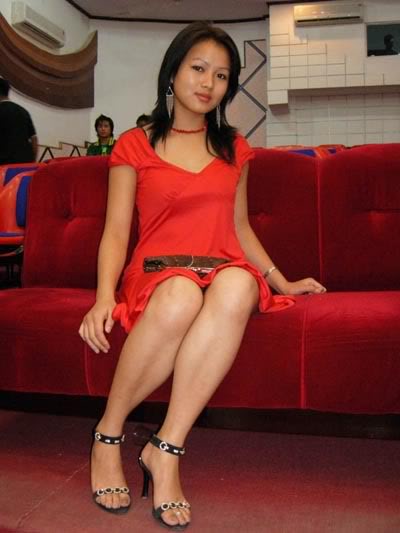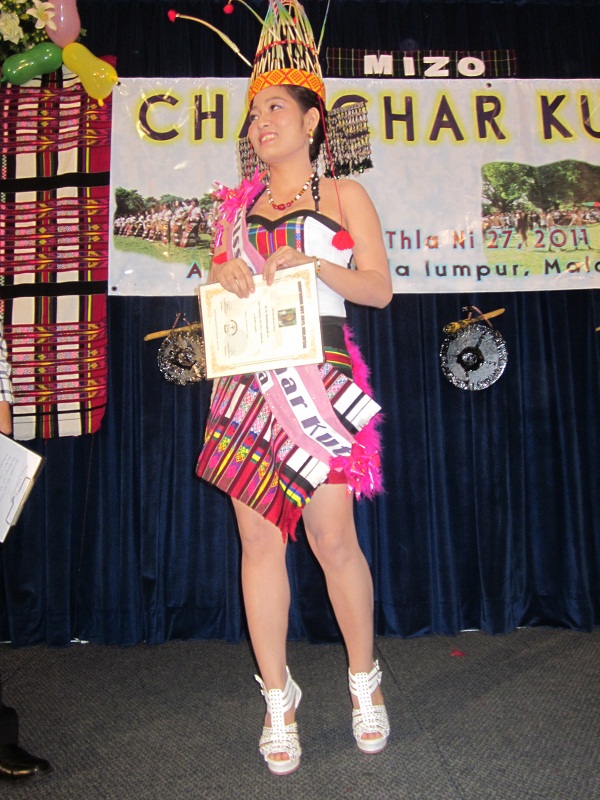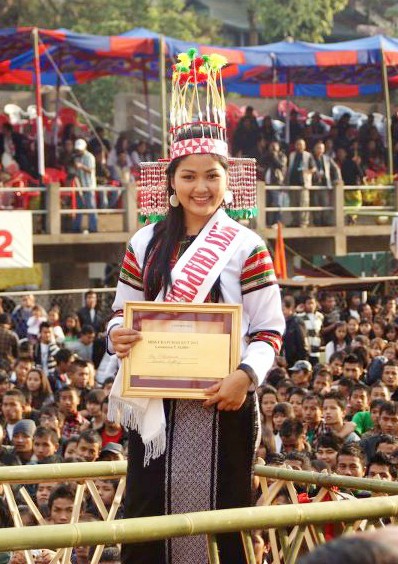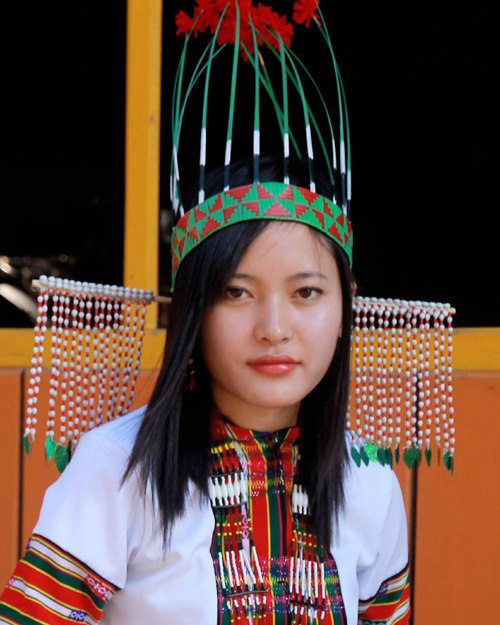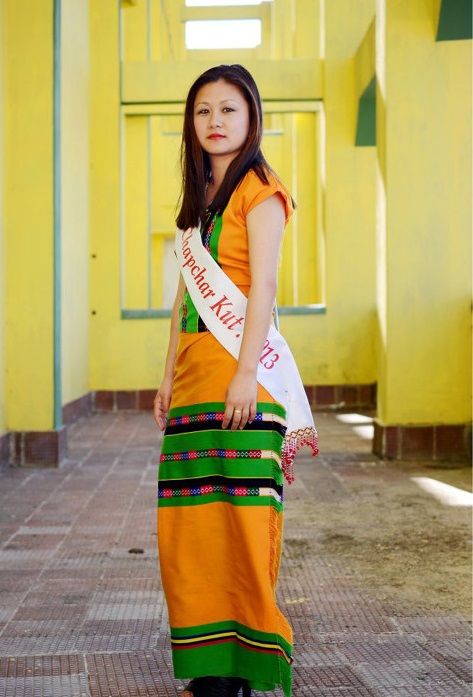Chapchar Kut
(→The Chapchar Kut Festival) |
(→The Chapchar Kut Festival) |
||
| Line 20: | Line 20: | ||
[[File: Chapchar Kût 2013.jpg|Miss Chapchar Kût 2013: Lalrinhlui Hrahsel |frame|500px]] | [[File: Chapchar Kût 2013.jpg|Miss Chapchar Kût 2013: Lalrinhlui Hrahsel |frame|500px]] | ||
[[File: Chapchar Kût 2013b.jpg|Miss Chapchar Kût 2013 |frame|left|500px]] | [[File: Chapchar Kût 2013b.jpg|Miss Chapchar Kût 2013 |frame|left|500px]] | ||
| + | 1) '''The Chapchar Kut Festival ''' | ||
| + | |||
| + | [http://www.journeymart.com/holidays-ideas/festivals/chapchar-kut-festival.aspx JourneyMart] | ||
| + | |||
| + | 2) ''' Chapchar Kut: Rhyming with nature ''' | ||
| + | |||
| + | Dhirendra Kumar | ||
| + | |||
| + | [http://www.millenniumpost.in/NewsContent.aspx?NID=53219 MillenniumPost] 2 March 2014, | ||
| + | |||
| + | ==When= | ||
| + | At the end of February, when winter starts receding, the Mizos prepare the land for fresh planting. There are few days of relaxation before the serious business of sowing starts and that is when the Chapchar Kut festival is celebrated with gaiety and fervour across the state. The Chapchar Kut is one of the oldest festivals of Mizoram and has a great cultural significance. In 2014 the festival was celebrated on 7 March. | ||
| + | |||
| + | The Chapchar Kut Festival is an annual harvest festival of Mizoram which observes the advent of spring. It is the time when bamboos and trees that have been cut down to make place for 'jhum' (seasonal farming) are awaited to dry to be burnt. It is one of the oldest festivals of Mizoram and lasts for seven days. | ||
| + | |||
| + | The people of Mizoram practice jhum cultivation which is the main basis of farming and also the source of income in the region. Trees are cut down to make space for cultivation and are kept aside for several days to be dried and burned later. Chapchar Kut calls for the time of revelry when these chopped trees are kept for drying. | ||
| + | |||
| + | The celebration, categorized under the spring festival umbrella, is the most important festival and the only one regularly observed during the first week of March in Mizoram. | ||
| + | |||
| + | Chapchar Kut marks the preparation before the onset of the sowing season and is celebrated during the time when jungles are cleared, bamboos and trees are cut down, and the land is prepared for jhum cultivation. | ||
| + | ==Origin== | ||
| + | Chapchar Kut literally means - a festival held during the period when the bamboos and trees that have been cut down are being awaited to dry to be burnt for jhumming. During this brief layoff period of jhumming, the Mizo ancestors could have all the time for themselves. They spend their leisure hunting games, fishing, etc. | ||
| + | |||
| + | The Chapchar Kut festival evolved sometime between 1450 -1600 A.D. when the Mizo forefathers inhabit Lentlang. In the olden days, the festival could last for days and in the run up to the grand finale, there are well laid down steps to be followed. Everyone in the village have a role to play; of course, the youths were most involved in every stage of the preparation and in the festival itself. | ||
| + | |||
| + | ==How the festival is celebrated== | ||
| + | Folk music and traditional dance performances are the major festivities of Chapchar Kut. And people from various tribal communities, from all ages and walks of life come together and participate in this festival. Dressed in traditional attire, different tribal communities compete with each other in dance and music. | ||
| + | == Heroic deeds for the men== | ||
| + | To attain a position of distinction, a Mizo had to go through a series of ceremonies and perform many feats of heroic deeds. These ceremonies are always accompanied by a feast and to this feast, friends from nearby villages are invited - hence, Khuallam is the dance for the visitors or guests. The 'Chheih lam' is another community dance performed by both men and women. The war dance 'Solakia', a prerogative of the male population of the community, is accompanied by rhythmic beating of the drums Exhibition and sale of indigenous Handloom and Handicraft products and other tourist attractions like flower show, food festival, musical competition and different traditional games are also organized during the Chapchar Kut festival. | ||
| + | |||
| + | The festivities involve folk music performances which have a major appeal in the Chapchar Kut Festival. Liquor indulgence once used to be the key mode of merriment but with passage of time it has been done away with and now the focus is only on music and dance. Dressed in colourful traditional apparel, various tribal communities compete with each other in dance and music. A bamboo dance is also performed where only women take part. The men sit on the ground and tap the bamboos in rhythm against each other. It is a beautiful sight to watch the people of Mizoram dancing, dressed in outfits vibrant in colour and hats made from beads and feathers. | ||
| + | ==Bamboo and the other main dances== | ||
| + | On this day people of all ages, young and old, men and women dressed in their colorful costumes and distinctive head gears and jewelries, assemble and perform various folk dances, singing traditional songs accompanied by beating of drums, gongs and cymbals. They dance in joyous celebration of life, each team displaying the best of its region. These are generally group dances with a lot of bonhomie and courting woven into them. Some dances are strictly martial danced by strong virile warriors with their weapons and trophies. One dance perennially popular is the Cheraw or the 'bamboo dance' so called as long bamboo staves are used for this dance. This is the most colourful and distinctive dance of the Mizos requiring skill and an alert mind to perform. | ||
| + | |||
| + | The other main dances performed during Chapchar Kut are Khuallam, Chheihlam, Chai and Sarlamkai. 'Khual lam' is an auspicious dance performed by a group of dancers celebrating new beginnings. It is also a welcome dance for guests during community festivities. | ||
| + | |||
| + | The bamboo dance is one of the major attractions of Chapchar Kut where only women folk take part in it. It is a very interesting dance form where the men folks tap the bamboos and open and close in rhythmic beats as the dancer steps in and out gracefully to the beats of the bamboos. The festival is an amazing sight with people dressed in outfits vibrant in color and hats made from beads and feathers. | ||
| + | ==A time for forgiveness== | ||
| + | Designed to be a festival of joy, all disputes and differences that may be there in the community should be settled, even altercation between married couples was a taboo during the celebration of the festival. Abundant supply of meat must be there and home brewed liqour must be over-flowing to keep their spirit high. They danced away all their cares and made merry all night long. That sums up how the Mizos celebrate Chapchar Kut in the olden days when they were heathens. | ||
=Chapchar Kût 2013= | =Chapchar Kût 2013= | ||
Miss Chapchar Kût 2013: Lalrinhlui Hrahsel | Miss Chapchar Kût 2013: Lalrinhlui Hrahsel | ||
Revision as of 22:51, 9 March 2014
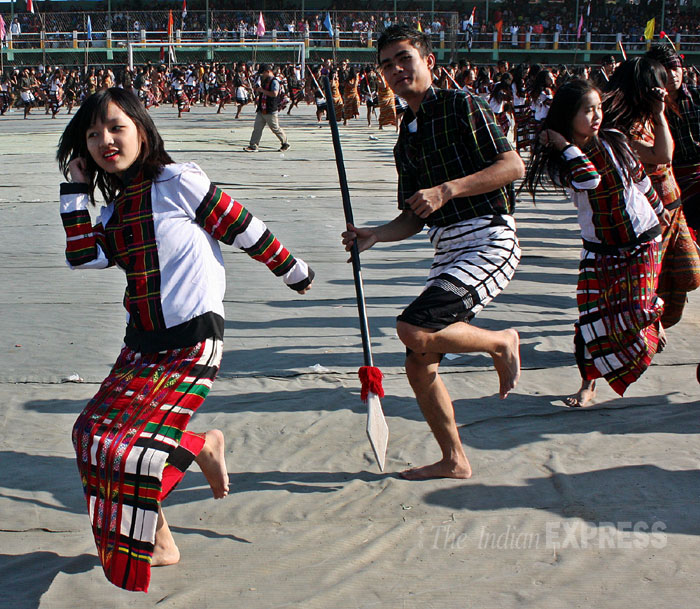
You can update or correct this page, send photographs and/ or |
Contents |
The Chapchar Kut Festival
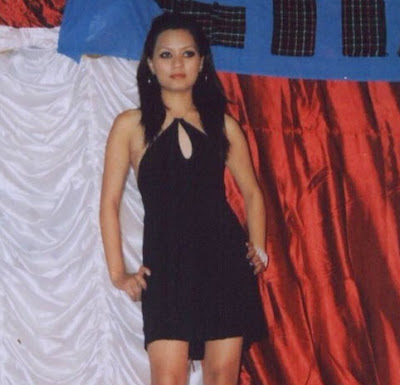
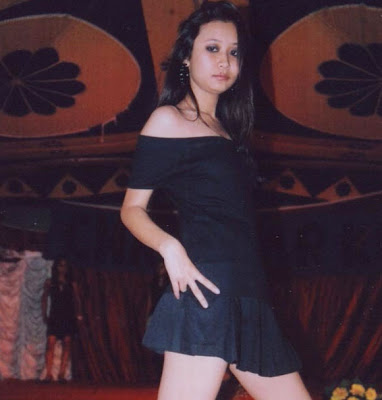
1) The Chapchar Kut Festival
2) Chapchar Kut: Rhyming with nature
Dhirendra Kumar
MillenniumPost 2 March 2014,
=When
At the end of February, when winter starts receding, the Mizos prepare the land for fresh planting. There are few days of relaxation before the serious business of sowing starts and that is when the Chapchar Kut festival is celebrated with gaiety and fervour across the state. The Chapchar Kut is one of the oldest festivals of Mizoram and has a great cultural significance. In 2014 the festival was celebrated on 7 March.
The Chapchar Kut Festival is an annual harvest festival of Mizoram which observes the advent of spring. It is the time when bamboos and trees that have been cut down to make place for 'jhum' (seasonal farming) are awaited to dry to be burnt. It is one of the oldest festivals of Mizoram and lasts for seven days.
The people of Mizoram practice jhum cultivation which is the main basis of farming and also the source of income in the region. Trees are cut down to make space for cultivation and are kept aside for several days to be dried and burned later. Chapchar Kut calls for the time of revelry when these chopped trees are kept for drying.
The celebration, categorized under the spring festival umbrella, is the most important festival and the only one regularly observed during the first week of March in Mizoram.
Chapchar Kut marks the preparation before the onset of the sowing season and is celebrated during the time when jungles are cleared, bamboos and trees are cut down, and the land is prepared for jhum cultivation.
Origin
Chapchar Kut literally means - a festival held during the period when the bamboos and trees that have been cut down are being awaited to dry to be burnt for jhumming. During this brief layoff period of jhumming, the Mizo ancestors could have all the time for themselves. They spend their leisure hunting games, fishing, etc.
The Chapchar Kut festival evolved sometime between 1450 -1600 A.D. when the Mizo forefathers inhabit Lentlang. In the olden days, the festival could last for days and in the run up to the grand finale, there are well laid down steps to be followed. Everyone in the village have a role to play; of course, the youths were most involved in every stage of the preparation and in the festival itself.
How the festival is celebrated
Folk music and traditional dance performances are the major festivities of Chapchar Kut. And people from various tribal communities, from all ages and walks of life come together and participate in this festival. Dressed in traditional attire, different tribal communities compete with each other in dance and music.
Heroic deeds for the men
To attain a position of distinction, a Mizo had to go through a series of ceremonies and perform many feats of heroic deeds. These ceremonies are always accompanied by a feast and to this feast, friends from nearby villages are invited - hence, Khuallam is the dance for the visitors or guests. The 'Chheih lam' is another community dance performed by both men and women. The war dance 'Solakia', a prerogative of the male population of the community, is accompanied by rhythmic beating of the drums Exhibition and sale of indigenous Handloom and Handicraft products and other tourist attractions like flower show, food festival, musical competition and different traditional games are also organized during the Chapchar Kut festival.
The festivities involve folk music performances which have a major appeal in the Chapchar Kut Festival. Liquor indulgence once used to be the key mode of merriment but with passage of time it has been done away with and now the focus is only on music and dance. Dressed in colourful traditional apparel, various tribal communities compete with each other in dance and music. A bamboo dance is also performed where only women take part. The men sit on the ground and tap the bamboos in rhythm against each other. It is a beautiful sight to watch the people of Mizoram dancing, dressed in outfits vibrant in colour and hats made from beads and feathers.
Bamboo and the other main dances
On this day people of all ages, young and old, men and women dressed in their colorful costumes and distinctive head gears and jewelries, assemble and perform various folk dances, singing traditional songs accompanied by beating of drums, gongs and cymbals. They dance in joyous celebration of life, each team displaying the best of its region. These are generally group dances with a lot of bonhomie and courting woven into them. Some dances are strictly martial danced by strong virile warriors with their weapons and trophies. One dance perennially popular is the Cheraw or the 'bamboo dance' so called as long bamboo staves are used for this dance. This is the most colourful and distinctive dance of the Mizos requiring skill and an alert mind to perform.
The other main dances performed during Chapchar Kut are Khuallam, Chheihlam, Chai and Sarlamkai. 'Khual lam' is an auspicious dance performed by a group of dancers celebrating new beginnings. It is also a welcome dance for guests during community festivities.
The bamboo dance is one of the major attractions of Chapchar Kut where only women folk take part in it. It is a very interesting dance form where the men folks tap the bamboos and open and close in rhythmic beats as the dancer steps in and out gracefully to the beats of the bamboos. The festival is an amazing sight with people dressed in outfits vibrant in color and hats made from beads and feathers.
A time for forgiveness
Designed to be a festival of joy, all disputes and differences that may be there in the community should be settled, even altercation between married couples was a taboo during the celebration of the festival. Abundant supply of meat must be there and home brewed liqour must be over-flowing to keep their spirit high. They danced away all their cares and made merry all night long. That sums up how the Mizos celebrate Chapchar Kut in the olden days when they were heathens.
Chapchar Kût 2013
Miss Chapchar Kût 2013: Lalrinhlui Hrahsel
